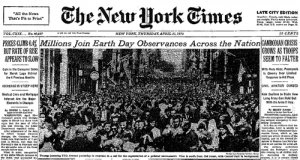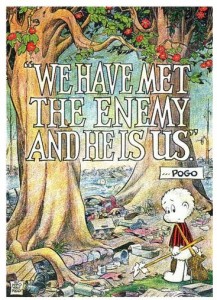Dear earth, I do salute thee with my hand,
Though rebels wound thee with their horses’ hoofs:
As a long-parted mother with her child
Plays fondly with her tears and smiles in meeting,
So, weeping, smiling, greet I thee, my earth,
And do thee favours with my royal hands.
— William Shakespeare, King Richard II, Act III, Scene ii
Among environmentally-conscious Americans, every April 22 is a cause for celebration and remembrance — Earth Day. Some environmentalists make a week of it. After recently editing my soon-to-be released book American Environmentalism: Philosophy, History, and Public Policy, I have been thinking of Earth Day lately. It figures prominently in the manuscript.
The first Earth Day occurred on April 22, 1970, and it has become an annual event since that time. The brainchild of U.S. Senator Gaylord Nelson of Wisconsin, the concept was born amidst the activism that swept across college campuses during the late 1960s. Nelson had grown up in rural Wisconsin — an area he referred to as a “magically mysterious” landscape — with a deep aversion to clear-cutting of forests by opportunistic timber companies. While serving as governor of Wisconsin from 1959 until 1963, he earned a pithy sobriquet — the “conservation governor” — for his reorganization of the state bureaucracy to create a single agency, the Department of Resource Development, designed to administer state parks more efficiently. He also created the Youth Conservation Corps to employ 1,000 young people in “green jobs.” At a time when the environmental movement was still in its infancy, Governor Nelson supported a program to devote $50 million for the Outdoor Recreation Action Program (ORAP), a state initiative to acquire land for conversion into public parks and wilderness areas.
A popular Democrat in the tradition of Robert M. La Follette, Wisconsin’s famed progressive governor and senator, Nelson followed in his hero’s footsteps by moving from the governorship to the U.S. Senate. He was elected in 1962, two months after the publication of Rachel Carson’s groundbreaking work on the dangers of environmental degradation, Silent Spring. Nelson was an environmentally-conscious legislator from an environmentally-conscious state who shared Rachel Carson’s concern for the indiscriminate use of DDT and other toxic chemicals. After reading Silent Spring, he sponsored national legislation to ban DDT use. Despite his best efforts, he could not persuade his congressional colleagues to support the measure. Until the public railed against a variety of national crises, enacting laws on environmental causes was politically unpopular. Consequently, during his first seven years in the Senate, Gaylord Nelson often appeared to be a lone voice crying in the wilderness, a sad, silly Cassandra surrounded by rational, indifferent neoclassical economists.
As times changed, Nelson’s approach changed as well. If he could not succeed in the legislative arena, he could carry his message through alternative mechanisms. Rather than pursue a fruitless top-down approach, perhaps a bottom-up grassroots campaign would succeed. In 1969, while the senator was sitting on an airplane flying back from a visit to California to witness the after-effects of an oil spill, he read an article about a “teach-in” organized by college students protesting American involvement in the Vietnam War. He experienced an epiphany. If students could call attention to anti-war messages through a teach-in, perhaps they would be willing to organize a teach-in for the environment as well. Congress might ignore a lone liberal senator decrying natural-resource destruction, but they would ignore a populist grassroots call for change at their peril.
In a series of speeches he delivered during the autumn of 1969, Nelson mentioned his idea repeatedly, although he did not call it “Earth Day.” As the press covered the speeches and reported on his recommendation, the senator was astonished to learn that major publications such as Time and the New York Times had published stories on the proposed teach-in. Recognizing that momentum was building, Nelson selected April 22, 1970, as the date for a “National Teach-In on the Crisis of the Environment.” By tapping into the youthful energy of the anti-war movement and scheduling a day of activism sandwiched between college spring breaks and final examinations, the senator sought to trigger an unprecedented national media event that would capture a wide audience similar to the way Silent Spring had appealed to the populace in the early 1960s.
Senator Gaylord Nelson was the chief architect of Earth Day 1970.
Nelson’s office was inundated with letters and telephone calls offering support for the teach-in on college campuses from coast to coast. Public school students, church-goers, and community organizers also pledged fidelity to the effort. Overwhelmed by the mounting press coverage, in November 1969 Senator Nelson convened a steering committee composed of academics, scientists, environmentalists, and students to serve as an information clearinghouse and a resource for coordinating the national efforts. Liberal Republican Congressman Paul McCloskey of California signed on to serve as the co-chair for the event. Treating the teach-in as a political event, Nelson and McCloskey tasked their staffs with developing a platform, recruiting student volunteers, holding fundraisers, and developing media materials, including posters, buttons, an official documentary, and even a popular song.
As a new year dawned and teach-in plans intensified, Senator Nelson insisted that he was not running a synchronized political event. The purpose was to mobilize support through a loose affiliation of grassroots organizations that would highlight environmental concerns in their respective communities. Deliberately eschewing a “one-size-fits-all” model, Nelson encouraged Americans across the country to participate “in any way they want.” To ensure that he would not become the de facto boss of the gathering, Nelson eventually established Environmental Teach-In, Inc., an independent non-profit organization located in Washington, D.C. Denis Hayes, a former Stanford University student-body president and current Harvard Law School student, became a leader in the effort after the senator asked for help. For their part, the Environmental Teach-In staff initiated a public relations campaign that included, among other things, a newsletter, resource packets, posters, and a campaign to encourage citizens to write their legislators requesting action to protect the natural environment. On January 18, 1970, they sponsored a full-page advertisement in the New York Times. For the first time, organizers used the phrase “Earth Day.”
The advertisement was a lesson in how to operate a provocative public relations campaign aimed at capturing maximum attention. “A disease has infected our country,” the copy read. “It has brought smog to Yosemite, dumped garbage in the Hudson, sprayed DDT in our food, and left our cities in decay. Its carrier is man.” After reciting a list of environmental problems, the group set forth its goals: “Earth Day is a commitment to make life better, not just bigger and faster; to provide real rather than rhetorical solutions. It is a day to re-examine the ethic of individual progress at mankind’s expense. It is a day to challenge the corporate and governmental leaders who promise change, but who short-change the necessary programs.” This challenge was all the more remarkable because it had been initiated by a governmental leader serving at one of the highest levels of federal service but who had voluntarily ceded control to the masses.
Earth Day 1970 captured national headlines.
On April 22, more than 20 million people congregated at thousands of colleges, universities, parks, and other public spaces throughout the United States. Although the timing and variety of events differed, most gatherings included speeches and songs by students and local activists denouncing oil spills, pesticides, toxic chemicals, the loss of wilderness lands, and air pollution. In New York City, Mayor John Lindsay closed off Fifth Avenue and made Central Park available for a massive rally of perhaps a million people. Movie stars Paul Newman and Ali McGraw attended. Other big cities featured large crowds that participated in all manner of community activities. Protest singer Pete Seeger spoke in Washington, D.C. before regaling the crowd with his music. In Philadelphia, students called for an entire week devoted to publicizing environmental degradation because one day was insufficient to accomplish their ambitious goals. As expected, the events generated a barrage of media coverage. CBS News ran a one-hour prime-time television special titled “Earth Day: A Question of Survival” narrated by Walter Cronkite, one of the most venerated newsmen in America.
Earth Day 1970 was established as a national "teach-in."
Senator Nelson appeared at an event in Denver, Colorado. “Earth Day is dramatic evidence of a broad new national concern that cuts across generations and ideologies,” he told his audience. “It may be symbolic of a new communication between young and old about our values and priorities.” Environmental efforts must not end with one symbolic day of speeches, music, and parades, however. To succeed, Nelson explained, the event must lead to a new awareness and eventually to legislative action. Linking environmental issues to other problems of the era, Nelson remarked that “Earth Day can — and it must — lend a new urgency and a new support to solving the problems that still threaten to tear the fabric of this society...the problems of race, of war, of poverty, of modern-day institutions.” As bad as those problems were, he explained, “Winning the environmental war is a whole lot tougher challenge by far than winning any other war in the history of man.” Winning the war was difficult because the objectives were so broad. “Our goal is not just an environment of clear air and water and scenic beauty. The objective is an environment of decency, quality and mutual respect for all other human beings and all other living creatures.”
Earth Day met Gaylord Nelson’s original objectives, although the event evolved from a teach-in to a campaign for changing national environmental policy. By organizing a peaceful mass protest aimed at raising awareness of environmental problems without undermining the grassroots character of the event, he and his fellow organizers allowed the citizenry to voice its hopes and fears regarding natural-resource preservation and protection. Many environmental laws and regulations promulgated after 1970 would have been difficult to enact were it not for the increased awareness and the bottom-up grassroots activism that resulted from the initial event. When asked why he did not pursue a top-down effort with assistance from political leaders, celebrities, and organized interest groups such as the Sierra Club, the Audubon Society, the Izaak Walton League, or the National Wildlife Federation, Senator Nelson commented, “No one could organize 20 million people, 10,000 grade schools and high schools, 2,500 colleges and 1,000 communities in three and a half months, even if he had $20 million. The key to the whole thing was the grass-roots response.”
Yet everyone involved knew a single event could not guarantee that environmental issues would remain on the national agenda and permanently enter the public consciousness. Awareness alone does not a policy make. Denis Hayes immediately moved to formalize the Earth Day Network, a new organization dedicated to promoting environmental awareness year-round and campaigning for policy changes at all levels. The group included non-governmental organizations (NGOs), quasi-governmental agencies, local governments, activists, and other citizens interested in promoting environmental education and improving public policy through public relations campaigns and grassroots celebrations in addition to Earth Day. By the beginning of the twenty-first century, the Network could boast of an international reach: Over 19,000 organizations in 192 countries worked with the group.
Other organizations sprang up to take advantage of new interest in environmentalism. A group called Environmental Action began an ongoing campaign to coordinate future Earth Day activities and call attention to the “dirty dozen,” manufacturing and chemical companies with abysmal records of polluting the environment. The organization’s website employed tough, muscular prose to discuss its agenda: “We turn ideas into impassioned, results-oriented activism that protects our environment from polluters and their allies in government. We never flinch from a fight. We always put the planet first. We hold the powerful accountable and speak for the trees.”
The League of Conservation Voters formed in 1970, drawing members and resources from several existing groups, “to turn environmental values into national priorities,” according to the non-profit organization’s website. “To secure the environmental future of our planet, LCV advocates for sound environmental policies, elects pro-environment candidates who will adopt and implement such policies, and provides state LCVs with the resources and tools to accomplish and sustain their mission.” During the twenty-first century, the group’s slate of issues included global warming, clean energy, clean water, toxics, wildlife, public lands, and oceans and coasts.
Not everyone was smitten with the Earth Day concept. Aside from industry representatives who contended that the effort smacked of anti-business opportunism that was unnecessarily alarmist and histrionic, some environmentalists worried that Earth Day served, and continues to serve, as an annual celebration of vague, amorphous ideals and collective liberal guilt. In some instances, Americans drive their gas-guzzling sport utility vehicles to the local park, stopping off at the nearest organic health-food store to purchase disposable picnic products in theoretically “green” disposable packaging along the way, only to arrive at the festivities, bow their heads, and curse mankind’s wicked, wicked ways. After chatting with their friends and neighbors about the ball game or the local school-board elections, joining hands to sing a rousing chorus of “Kumbaya,” and listening to strident speeches delivered by idealistic young students with no life experience, they return home to bury their faces in electronic gadgets that suck fossil-fuel-generated electricity from their home outlets at record levels. If this is the ultimate legacy, critics contend, Earth Day was a failure. Environmentalists were co-opted by mainstream Americans who care about environmental issues as long as their standard of living is not imperiled and their lives are minimally inconvenienced.
Cartoonist Walt Kelly's character Pogo uttered a famous catchphrase that eventually was associated with Earth Day: "We have met the enemy and he is us."
Adding to the criticism, other environmentalists argued that the time and energy devoted to tilting at windmills through meaningless, symbolic Earth Day celebrations could be devoted to genuine, substantive issues such as overpopulation. A Stanford University biology professor, Paul Ehrlich, published a groundbreaking book, The Population Bomb, in 1968, shortly before the first Earth Day. The book called attention to the crisis of overpopulation facing the world. An updated version of Thomas Malthus’s eighteenth-century thesis that population growth eventually will outpace the world’s ability to feed its people, thereby leading to mass starvation, The Population Bomb set forth a provocative, alarming proposition. Because “Americans are beginning to realize that the underdeveloped countries of the world face an inevitable population-food crisis,” Ehrlich wrote in a section titled “Too Many People,” the problem could no longer be ignored. “Each year food production in these countries falls a bit further behind burgeoning population growth, and people go to bed a little bit hungrier. While there are temporary or local reversals of this trend, it now seems inevitable that it will continue to its logical conclusion: mass starvation.” Although the worst predictions of a Malthusian catastrophe failed to materialize, the fear that the “human footprint” was decimating the planet fit neatly with the alarmism of many environmental activists.
For better or worse, Earth Day has become an annual event. I discuss this issue, among many others, in my book American Environmentalism: Philosophy, History, and Public Policy, available in August 2013.







